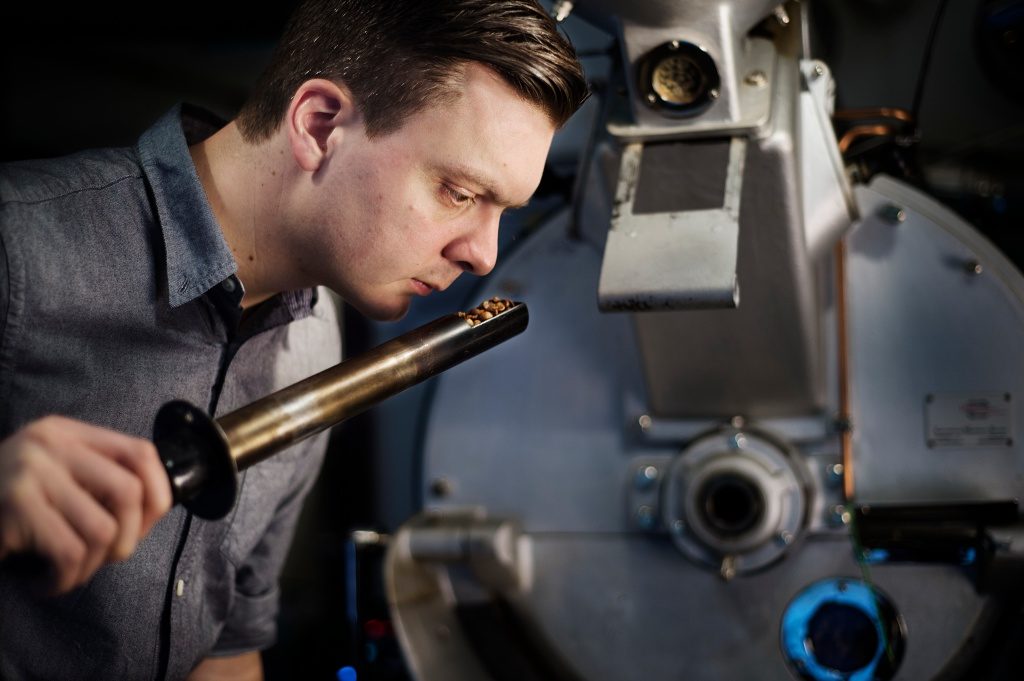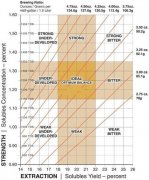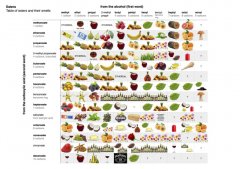Tim Wendelboe, the champion of Nordic Baking Competition: the characteristics and key points of Nordic Baking

For professional baristas, please follow the coffee workshop (Wechat official account cafe_style)
Tim made it clear at the beginning that the so-called Nordic shallow roasting is a term given by the rest of the world, and he can only share his preference for coffee, not all Nordic coffee.
The relationship between Water quality and Coffee
Denmark because the TDS is too high, the water contains high calcium and carbon, will make the coffee drink light; Iceland has volcanic lava, so that the water tastes like boiled eggs, even after the filter, the coffee flavor is still a bit strange; and Norway has a lot of surface water from lakes or rainfall, the quality is very clean, almost comparable to bottled mineral water.
If baking is considered in terms of water quality, water with high mineral content is usually baked deeper, while water with low mineral content (such as Norway) can be baked shallower. So if you take your own baked beans to other countries, the results may be quite different.
Tim Wendelboe's baking preferences
It is hoped that the original flavor of coffee beans can be emphasized when baking, so as not to be affected too much by baking. The focus is on the characteristics of the varieties that can drink from the place of origin, and do not like the changes caused by the dry distillation reaction after baking. Variety and origin are very important conditions that affect coffee. If you buy variety X today, you hope to drink the taste of variety X and the characteristics of the place of origin.
Take Kenya as an example: if you drink varieties at high altitude, you will want to have bright acidity, while at middle altitude, you will want to have obvious fruit flavor. If you drink at low altitude, you may want to have the tonality of nuts and peanuts. If you come from the west, you will want the taste to be a little more detailed, while if you come from the center, you will expect the taste to be stronger.
For Tim, the change caused by the treatment of raw beans is not the flavor change he pursues. For him, he almost uses the word "flaw" to describe the change caused by the treatment. For example, sun-dried beans, which may come from Brazil, Ethiopia or El Salvador, are likely to taste like grass, which is the taste produced by fermentation during sun treatment. Tim stressed that it is not wrong to like sun-dried beans, but we should understand that the taste comes from the treatment, not the beans themselves. Although "flaws" can also bring about "positive" changes, such as Greece and Turkey, they like phenolic beans very much.
Another flaw is overbaked beans, which makes different varieties of coffee taste the same, which is also a flaw for him, which may not be thought of by others, but it is true that overbaked beans will make beans of different varieties and regions very similar.
Views on comprehensive formula beans
About two or three years ago, Tim asked himself why he wanted to make comprehensive formula beans. He visits the producing area about 50 days a year and tries different kinds of coffee beans produced by different producing areas, elevations and climates, each of which has its own characteristics, so why should I mix all these beans and make them taste the same? Since then, he has stopped making comprehensive formula beans (Italian beans in Tim are also individual, but slightly more baked).
Tim believes that formula beans and high-quality beans contradict each other. Called specialty Coffee certainly has something special, if everything is the same, then this kind of coffee is not special, has the uniqueness, can be called boutique coffee. Because we only focus on making one kind of bean, baking one kind of bean, and extracting one kind of bean at a time, we know more about a kind of coffee. If there is a person who has a lot of good red wine, but drinks it all together, what's the point? (laughter).
About the depth of baking
We know that espresso will magnify the characteristics of beans, and so will baking. if baking is not fully developed, it will drink too sour, and if it goes too far, it will become bitter.
For Tim, baking has to go back to the place of origin. If the beans are not good enough, they will not taste good. The reason why they spend so much time working there is to get the best materials. On the farm, he irrigates with farmers, and when harvest time, he collects samples with farmers. Tim bakes samples locally, tests them with local farmers and cup testers, selects the best samples, takes them back to Norway, then uses Norwegian water to bake them again, cup tests again, and picks out his favorite beans before placing an order with farmers from the producing area. Farmers will then send a sample of the bean to Norway and Tim will compare it to see if the final sample is the same as before. Finally, when the beans are shipped to Norway, he will use different baking methods to test the effects of different baking methods on the beans. So before he decided how to bake the bean, he had tried the bean at least five to seven times, using different baking methods, different samples, and different water quality.
He believes that there is no best baking method, only different ways can be set for different beans, and this depends on individual tastes and preferences. Tim likes Kenya beans because he likes the "tea" and rosy aroma of Kenya beans, which are highly sour but not bitter. But his friends like to bake it deeper to bring out the aroma of blackcurrant. Perhaps in the strength and acid quality will be relatively reduced, but the alcohol thickness will be increased, the final rhyme will be a little more astringent and sweet. The depth is everyone's preference, when a bean baker gets the raw bean and decides to bake it very shallow, he should think, "am I sure?" Do I like the shallow taste? Or is it better to go deeper? "or use the flavor wheel to confirm.
In Nordic style, the flavor will fall on the flavor of partial enzymes, that is, the position where the degree of baking is shallow, and as far as he knows, like Japan, it sometimes falls down to the position of caramelization, while in North America, it sometimes goes down to the flavor near the dry distillation reaction. I would like to stress here that there is no absolute right or wrong, it is simply what everyone likes.
He observed that the reason why northern Europe accepts sour coffee may be that their food is also sour (fermented foods such as vinegar or cucumber pickles). So when baking beans, do not want to bake deep or shallow, but to think about which baking method can best bring out the flavor of the origin and variety. For example, what is the typical flavor of beans today if they come from the Sidamo producing area of Ethiopia or the non-producing area of Yegashiro? If you understand their characteristics, the baker should not bake the beans to such an extent that they will produce a dry distillation reaction, but instead move in the direction of enzyme flavor.
Another example is the beans in the south of Honduras, which usually have herbal plants and fine fruit flavor, and sometimes have caramel and fruit flavor, so when baking beans, you can consider that if you want to highlight the herbal flavor, it may not be too deep, but it can't be as shallow as Yega Xuefei mentioned above. In addition, you can't expect to bake flowers in beans in Honduras, because you can't bake them to produce flavors that are not found in beans. Bean bakers should be aware of the characteristics of beans, Geisha or bourbon, and then decide how to bake a cup of coffee, and then emphasize its origin characteristics.
Important Notice :
前街咖啡 FrontStreet Coffee has moved to new addredd:
FrontStreet Coffee Address: 315,Donghua East Road,GuangZhou
Tel:020 38364473
- Prev

SCAA American Fine Coffee Association standard cup measuring coffee grind, medium light dark roast coffee brew
From the comparison table, determine the predetermined coffee brewing amount and set the upper and lower limits of coffee powder amount, how to reach the optimal extraction rate from 0~30% to 18~22%, and the coffee brewing concentration is just 1.2%~1.45%, just like how to throw a good shot. After brewing a cup of Gold Cup coffee, whether the above basic powder amount and brewing amount can achieve the optimal extraction rate of 18%~22% and the concentration at the same time
- Next

Why does ice drop coffee have wine rhyme and smell? The reason why ice drop coffee smells like alcohol.
Professional barista communication please pay attention to the coffee workshop (Wechat official account cafe_style) esters are one of the main substances that create the aroma of fruit, we experience the stimulation of this flavor from the fruit, also remember it with the fruit, and then when our sense of smell comes into contact with them again in other environments (
Related
- Beginners will see the "Coffee pull flower" guide!
- What is the difference between ice blog purified milk and ordinary milk coffee?
- Why is the Philippines the largest producer of crops in Liberia?
- For coffee extraction, should the fine powder be retained?
- How does extracted espresso fill pressed powder? How much strength does it take to press the powder?
- How to make jasmine cold extract coffee? Is the jasmine + latte good?
- Will this little toy really make the coffee taste better? How does Lily Drip affect coffee extraction?
- Will the action of slapping the filter cup also affect coffee extraction?
- What's the difference between powder-to-water ratio and powder-to-liquid ratio?
- What is the Ethiopian local species? What does it have to do with Heirloom native species?

